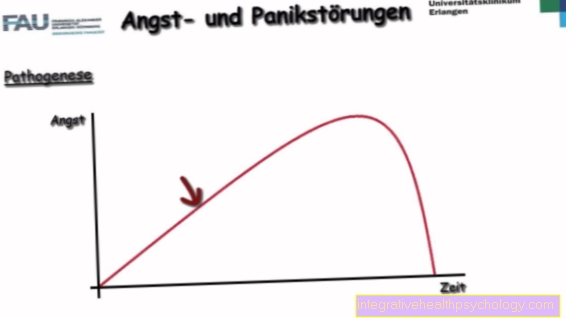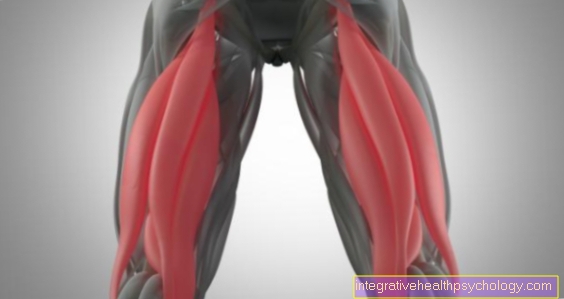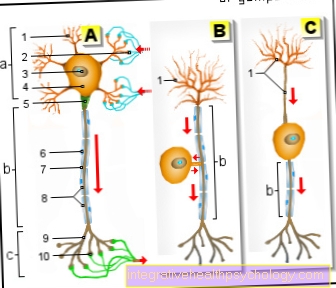Atheromatosis
definition
The term atheromatosis is often very misleading. Both benign soft tissue tumors and fatty deposits in the walls of arterial vessels are called atheromas. The term atheromatosis refers to the appearance of atheromatous plaques, also called atheromas, in the vessel walls of arteries. These are cholesterol-containing deposits on the innermost layer of the arteries that can block the vessels. This creates vascular occlusions that lead to organ damage in the arterial supply area. The terms atheromatosis, arteriosclerosis, and atherosclerosis are often used interchangeably, although this is not strictly speaking. Most likely, the terms atherosclerosis and atheromatosis can be used synonymously. Atherosclerosis simply describes the hardening of the arterial wall, regardless of the cause, whereas the term atheromatosis refers to deposits containing cholesterol in the vascular walls.

causes
There are several causes of atheromatosis. When developing atheromatosis, a distinction is made between main and secondary risk factors. Some of the factors can be influenced. The main risk factors for atheromatosis include tobacco consumption, diabetes mellitus, high blood pressure and hyperlipoproteinemia. Hyperlipoproteinemia is an increase in LDL cholesterol. This should be below 160mg / dl in the normal range. In the case of previous illnesses, such as diabetes or high blood pressure, one even strives for lower values. Furthermore, a decrease in HDL cholesterol is a negative factor influencing atheromatosis. That may sound like a contradiction in terms, but it can be explained quite simply: HDL cholesterol is the so-called "good cholesterol" that is transported from the blood vessels to the organs for further processing. Therefore it is not deposited in the vessel walls. The lower the HDL and the higher the LDL, the greater the likelihood of vascular deposits. Another major risk factor for atheromatosis is heart attacks in first-degree relatives. Especially when family members at a younger age (women under 65, men under 55) are affected, this indicates an increased risk due to a kind of predisposition to atheromas in the vessel walls. Other risk factors for atheromatosis are obesity and high levels of triglyceride fats in the blood.
Read more on the topic: Fats in the human body, blood circulation disorder from smoking
diagnosis
Atheromatosis can lead to different symptoms depending on the affected vascular region. However, it is present a long time before symptoms appear. The deposits in the vessels are often noticeable through routine check-up examinations at the family doctor, in which large vessels are examined with the ultrasound. There you can see whitish deposits, which, depending on the age of the person affected, can be age-appropriate or pathological. However, the diagnosis can also be made if symptoms such as circulatory disorders have already occurred. The closure of the leg vessels can, for example, lead to a lack of foot pulses or pain while walking. Occlusions in the coronary arteries cause angina pectoris symptoms such as shortness of breath and tightness of the chest. A deposit in the carotid arteries can become symptomatic through dizzy spells or even fainting spells. All of these symptoms can be examined in more detail, thereby making it possible to diagnose atheromatosis.
Read more on the topic: Dizziness and racing heart
Concomitant symptoms
Atheromatosis leads to different symptoms depending on its severity and location. It usually goes undetected for years before the first symptoms appear. Symptoms only occur when vessels are narrowed or closed by the deposits.
Angina pectoris is a common complex of symptoms that can arise from atheromatosis. A narrowing of the small coronary arteries, which supply the heart muscle with oxygen-rich blood, leads to seizure-like symptoms consisting of shortness of breath, tightness of the chest, sharp pain, panic and sweating. These complaints can occur at rest or after exercise. If one or more of these vessels is completely blocked, a heart attack occurs. This manifests itself as persistent chest pain that can radiate into the left arm. Accompanying symptoms such as nausea, sweating or vomiting occur. In women, a heart attack is usually less symptomatic. Chest pain may be completely absent or only very mild. Diffuse abdominal pain or back pain are much more common.
Read more on the topic: Burning in the chest, palpitations - how dangerous is it? or shortness of breath
In addition to the coronary arteries, atheromatosis can also cause other vessels, such as the carotid arteries (Common carotid artery) affect. Here too, symptoms usually only arise when the atheromatosis is already very pronounced and the inside of the vessels is becoming increasingly narrow. Such a narrowing of the carotid arteries, too Carotid stenosis called, may be noticed by dizziness and fainting spells. Another possible complication is temporary blindness in the eye of the affected side. This painless blindness that passes by itself is known as Amaurosis fugax. However, amaurosis fugax should not be taken lightly. It is an urgent warning sign of an impending stroke and should therefore lead to prompt treatment of the vasoconstriction.
Read more on the topic: Stroke in the eye, clogged carotid artery - what to do?
Also a so-called TIA - transitory ischemic attack - which resembles a stroke, can be a complication of narrowing of the carotid arteries. It is characterized by symptoms such as speech disorders, paralysis of the arms or legs on one side, impaired vision, and loss of consciousness. Unlike a stroke, however, the symptoms are temporary and not as pronounced. A TIA should also be clarified immediately, as the risk of a stroke in the further course is very high.
Read more on the topic: Stroke - what are the signs?
Ultimately, atheromatosis can also affect the vessels in the legs and feet and lead to circulatory disorders there. Depending on their severity, these are characterized by pain when walking, cold feet and legs, poorly healing wounds on the feet and a shortening of the walking distance. Those affected have to take breaks more often and can no longer go as far as before.
Read more on the topic: Circulatory disorders in the feet, causes of pain in the legs
Treatment / therapy
In principle, there are various special therapeutic approaches for atheromatous diseases, which are dependent on the disease, as well as general measures. First of all, general measures include reducing or eliminating factors that promote and worsen atheromatosis.
The most important measure is a complete cessation of tobacco use. Furthermore, if you are overweight, you should reduce your weight. A Mediterranean diet with good oils such as olive oil and lots of vegetables is particularly recommended for people with atheromatosis. It has a positive effect on the blood vessels and lastingly improves the fat levels in the blood. Furthermore, moderate endurance training, such as jogging for 20 minutes three times a week, is important in order to improve the blood flow to the organs and tissues.
Read more on the topic: How to quit smoking - but how ?, stomach-off diet, endurance exercise and fat burning
Blood-thinning medications such as ASA or clopidogrel can also be used to minimize the risk of clots and heart attacks. The fat balance is controlled with so-called statins so that the LDL value can be set in a target range depending on the risk of the person concerned and the symptoms. This cholesterol fat value should be between <160- <170 depending on the patient. Other risk factors, such as diabetes or high blood pressure, are also treated with medication so that they do not worsen the atheromatosis any further.
Read more on the topic: Blood thinners, medicines for circulatory disorders
In the case of existing damage, such as a stroke, heart attack, chronic kidney failure or arterial occlusive diseases, special therapies are used that are adapted to the clinical picture. These usually also consist of anticoagulant drugs on the one hand and vasodilating interventions such as stent implantation on the other. The goal is always to ensure good blood flow to the organs or tissues and to expand the narrowed vessels again.
Read more on the topic: Implantation of a stent after a heart attack
forecast
Atheromatosis is a serious disease that, depending on its severity, has a different prognosis for those affected. If it is recognized early, much can be done to counteract the progression of vascular deposits and the associated potential consequential damage. In advanced forms, however, the prognosis can be very poor, for example if strokes or heart attacks have already occurred. Then the atheromatosis is already very pronounced. Even in these cases, however, it is often possible to prevent further complications through close examinations and consistent therapies.
Forecast by location
aorta
Deposits in the aortic vessel wall can result in an aortic aneurysm or aortic dissection. An aortic aneurysm is a bulging of the vessel that usually does not cause any symptoms. Often the aneurysm is discovered only by chance during a CT scan. Rarely, it can lead to unspecific complaints such as a feeling of pressure in the chest, back pain or colicky flank pain. A very large aneurysm can press on nearby organs and nerves in the chest, causing discomfort. These include difficulty swallowing, hoarseness or a drooping eyelid.
An aortic dissection is a split in the vascular wall with the formation of a second vascular canal within the vascular wall layers. Atheromatosis is also an important causative factor for this, along with other diseases such as high blood pressure or a connective tissue disease. An aortic dissection can have serious complications, such as heart attacks, strokes, or bleeding.
Read more on the topic: Aortic tear - causes, symptoms, therapy, prognosis
Carotid artery
Atheromatosis of the carotid artery, also known as the carotid, is often noticed in check-up examinations at the family doctor. An ultrasound scan of these large arteries in the neck will reveal whitish deposits in the vessel walls. These do not cause symptoms for a long time because enough blood can still flow through the large interior of the artery. Only when the deposits are so pronounced that not enough blood can flow through them do complaints arise. This is known as symptomatic carotid stenosis. The constriction can cause symptoms such as dizziness or fainting. A so-called TIA (transitory ischemic attack), a harbinger of stroke, can occur. Symptoms such as temporary blindness in one eye (Amaurosis fugax), Paralysis of the arm and leg on one side, speech disorders or loss of consciousness. Symptomatic carotid stenosis or a very pronounced narrowing should be treated by removing the debris and reopening the vessel (Thrombandarterectomy).
Read more on the topic: Cerebral haemorrhage, cervical spine syndrome, pain in the carotid artery
Coronary arteries
Atheromatosis of the coronary arteries is also known as coronary artery disease, or CHD for short. The small coronary vessels are important for supplying the heart muscle with oxygen-rich blood. When the coronary arteries are narrowed by atheromatosis, the heart muscle is insufficiently supplied with oxygen. This leads to the widespread symptom complex of angina pectoris. Consists of stabbing chest pain, nausea, and shortness of breath. This usually improves with the administration of the drug nitroglycerin. A complete narrowing of a coronary artery or a so-called plaque rupture can lead to a complete heart attack. A plaque rupture is the detachment of a vascular deposit, also called plaque. The detachment of the plaque can lead to a blockage of the vessel in a narrower section of the vessel and thus to a heart attack.
Read more on the topic: Diagnosis of coronary heart disease, therapy of coronary heart disease, nutrition for heart diseases





























